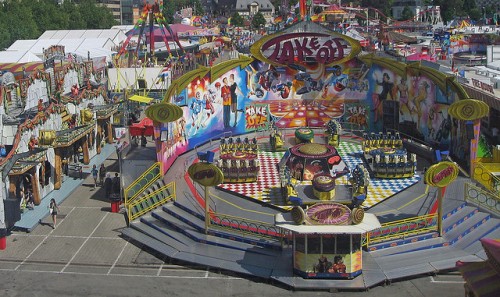
There are ways, though, to make a day at the fair into a budget-friendly day out that can scratch that theme park itch at a fraction of the price. You just have to go in the gates armed with a budget and a plan and then stick to both. Here are some ideas for reining in the cost of fairs and carnivals.
Buy tickets in advance
Many larger fairs offer the chance to buy tickets in advance. At our major fair, admission tickets are $2 less if bought in advance and ride tickets, which are $1 apiece at the fair, can be bought in sheets of 18 for $10. That’s a savings of eight dollars on every eighteen tickets. If you can buy in advance, do so.
Take advantage of unlimited passes
Some fairs offer unlimited ride passes, either on special days or throughout the fair. The price seems high at first, but if you do the math it usually works out in your favor if you ride a lot. Since rides are a big money drain, take advantage of the unlimited pass if you plan to ride a lot.
Bring your own food
Many fairs allow you to bring in your own food. Those that don’t allow it in the gates often don’t prohibit tailgating. Rather than pay big bucks for soda and snacks at the fair, bring your own.
Share food
If you love fair food, pick the one thing you really want and share it with your group rather than having each person buy their own. Most fair foods are large and you don’t need all the fat and calories yourself, so sharing can save your wallet and your waistline.
Limit the rides
Since rides are a big money sink at most fairs, go into the gates with a firm limit in mind. Limit each person to, say, just five rides. The super rides can run anywhere from $5 to $8 apiece with kiddie rides costing less. Limiting the number of rides can save a small fortune. (Hint: Watch the ride before ponying up the money. Some fairs are chintzy with the rides, giving you just one or two full turns of the ride. You don’t want to pay $6 for something that’s over before you even get settled in the seat.)
Give kids a budget
Kids will want to ride, eat, and play everything that they see. Give your kids a set amount to spend and let them know that when it’s gone, it’s gone. If they want to blow it five minutes inside the gate, that’s their decision. Encourage them to see everything before deciding how to spend their money. This will help teach kids about spending wisely. Keep the bank of mom and dad closed to spare your budget.
Take advantage of “special” days
Some fairs offer military appreciation days where service members get in for free or a reduced price, senior citizen days, or days that you can get in for free if you bring in food for a food bank, for example. If yours offers such promotions, take advantage of anything for which you qualify.
Avoid the games
Next to the rides, the games are the other big money sink at a carnival. Most cost $1 to $3 to play and they are very hard to win. If you must play something, limit yourself to one try and then move on. The fair is betting that you’ll get competitive and keep trying until you beat the thing. If you do that, you might as well buy a souvenir from the souvenir stand. You’ll probably come out ahead.
Find the free stuff
At most fairs, there are free performances and exhibits. You can see the work of local craftspeople, check out the animals and prize-winning foods, and see local performers. Some of the exhibits are interactive with things like scavenger hunts, quizzes, and skill tests. The free stuff may not be as sexy as the big rides, but it’s fun and educational.
Compete
Most large fairs offer competitions in almost every craft or skill imaginable and most are judged by age group so little kids aren’t competing against adults. You might win a cash prize that will cover the costs of your day at the fair. Even if you don’t win, some fairs offer free admission to exhibitors.
Work
Some fairs offer free admission or rides to workers. While the carnival usually brings in its own people, they sometimes hire temporary help from the local area. You might also get these benefits if you volunteer to work at the booth sponsored by your church, school, or civic organization.
Skip the freak shows
The two headed boy, the girl with body of the snake, and the worlds largest horse all sound interesting, but they are pricey and usually not worth the money. Despite the claims that these things are “live,” most are faked in some way. You end up paying two dollars to see an alligator that was stuffed (or manufactured) fifty years ago.
When I go to the fair, I tend to spend most of the day checking out the exhibits. I may ride a couple of old favorites like the Ferris wheel and eat my one favorite food, but by purchasing my tickets in advance and limiting the expensive stuff, I can spend a fun day at the fair for under $40.
Don’t go to a fair without a firm budget in mind and a game plan. If you just wander around paying for everything that catches your eye, you’ll easily spend the equivalent of a theme park vacation. If you’re smart, though, you can enjoy a great, low-cost day out.
(Photo courtesy of wfbakker2)

Jennifer Derrick is a freelance writer, novelist and children’s book author. When she’s not writing Jennifer enjoys running marathons, playing tennis, boardgames and reading pretty much everything she can get her hands on. You can learn more about Jennifer at: https://jenniferderrick.com/.
Comments